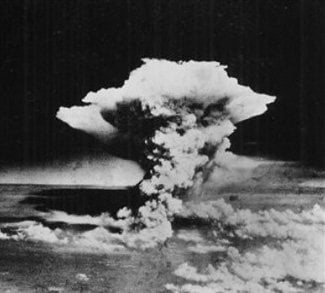In mid-December 1960, a conference was held at Strategic Air Command headquarters near Omaha, Nebraska, to outline America’s nuclear war strategy. During the meeting, plans were revealed whereby Moscow alone would be hit by 40 megatons of nuclear weapons. That is: about 4,000 times the force of the atomic bomb that leveled Hiroshima, on 6 August 1945.
Forty megatons also exceeded, by up to 30 times over, the full outlay of Allied conventional bombing during the Second World War. US General Thomas Power, commander-in-chief of Strategic Air Command, outlined at this meeting that radioactive fallout from the bombings would kill about 100 million Soviet citizens – roughly four times the total wiped out by the Nazis. The 100 million death toll was from radioactive fallout alone, not taking into account the further millions that would be killed by the bombs’ direct impact and blast radius.
Neighboring China was also to be decimated by American nuclear attacks; in 1949, the US had “lost China to Communism” following a revolution led by Mao Zedong. General Power noted at the conference that “there are about 600 million Chinese in China”. His chart quickly revealed that following planned nuclear attacks on the country, 300 million Chinese would be killed. Almost all the fatalities would constitute civilians.
One of those in attendance then asked whether they could change the strategy for “just a war with the Soviets?” General Power replied, “Well yeah, we can, but I hope nobody thinks of it, because it would really screw up the plan”.
John H. Rubel, later president John F. Kennedy’s Assistant Secretary of Defense, who was present, wrote that he “shrank within, horrified”, and his mind wandered to “the Wannsee conference in January 1942”. Rubel notes that at this Nazi meeting in southwest Berlin “an assemblage of German bureaucrats swiftly agreed on a program to exterminate every last Jew they could find anywhere in Europe”. The American meeting almost two decades later, at the Offutt Air Force Base near Omaha, was planning for killings on a vastly greater scale to the Wannsee Conference, organized by sinister SS commander Reinhard Heydrich.
In attendance at the American conference were the Joint Chiefs of Staff, a list of general officers from various US commands across the world, and a small number of civilians. The Harvard chemistry professor George Kistiakowsky – an advisor to Dwight D. Eisenhower – informed the outgoing US president of the unprecedented death tolls predicted from such attacks. Though appalled by the news, Eisenhower approved the mass genocide proposal. Eisenhower even demanded that, mostly for budgetary purposes, no other plan for fighting the Russians should be formulated.
Eisenhower’s successor, president Kennedy, was later briefed of the impact of nuclear attacks that would result in the deaths of hundreds of millions. Like Eisenhower, Kennedy changed nothing and accepted the risks. As too did future presidents Lyndon B. Johnson and Richard Nixon – with much evidence to suggest the “major attack options” continued through the administrations of Jimmy Carter, Ronald Reagan and George Bush Snr (and most likely onto Donald Trump).
Furthermore, US pre-planned nuclear assaults were to target every city in both the USSR and China. With regard the USSR, there was one US nuclear warhead allocated for each place in the vast socialist state containing 25,000 people or more. Such attacks would also have knowingly wiped out America’s NATO allies in Europe. Soviet nuclear medium-range missiles and tactical bombers were pointed at their NATO adversaries, who would face annihilation in retaliatory strikes, as would the Warsaw Pact states. If there was any doubt, the radioactive fallout from America’s nuclear assaults on the USSR would then sweep across Europe, east to west, in a double whammy blow.
When president Kennedy assumed office in 1961, there were about 1,700 Strategic Air Command bombers in operation, comprising almost entirely of jet-powered B-52 and B-47 aircraft. Each plane was equipped with nuclear-armed weapons, ranging from five to 25 megatons in strength. The most powerful, 25 megaton bombs, contained 25 million tons of TNT – or over 12 times the entire bomb outlay the US Air Force dropped during World War II. A small number of B-52s were in the sky at all times, while much of the rest remained on alert.
Upon initiation of the US general nuclear war plan – an Execute order – it called for the departure of as many of these heavy bombers as possible. The fleet of hundreds would make their way onto each city in the Soviet Union and China, before releasing their arsenals.
Today, thousands of US nuclear weapons remain on “hair-trigger alert”, mostly aimed at Russian military installations, many of which are located in or close to cities. Such policies have been defended on the pretext of deterring a Soviet, or later Russian, nuclear first strike. In reality, the aggressive US nuclear strategy is designed to limit the retaliatory damage to America, following a nuclear first strike against Russia from the Western superpower.
Such contingencies are rendered meaningless anyway. To the current day, not foreseen by US planners is the nuclear winter effect following the initiation of a single such attack – by the US, or one of the other now eight nuclear powers. The extinction phenomenon of nuclear winter was not apparent to scientists until the early 1980s, when president Reagan was in office.
Even limited first-strike nuclear attacks, much smaller than those planned during the Cold War, would kill virtually every human on the planet, including all those in the US. As a consequence of nuclear explosions, firestorms would lift great levels of smoke and soot into the global stratosphere. It would remain there for 10 years or longer, blocking out the majority of sunlight, destroying harvests everywhere, while sinking the earth’s temperatures to Ice Age levels. Within two years, the human race would be virtually wiped out as a result of starvation.
In the US, throughout the Cold War years, the decision to begin a nuclear war did not rest with the president himself. Eisenhower delegated nuclear authority to his theater commanders who, in turn, passed on the initiative to their own subordinates.There was nothing to prevent a rogue commander, or officer, deciding that a nuclear attack was required and acting upon it. Any decision to initiate nuclear war against the USSR and China, could be taken by an armed force member the public had not remotely heard of. Nor were they informed of such policies, of course, which are one of America’s “highest national secrets”.
Americans were told such an earth-defining decision would be left to the president alone. However, a president, particularly with a low military rank or largely civilian background, was bound to be looked upon with suspicion by important military men. This was hardly the case during Eisenhower’s two terms, ending in January 1961, as he was a five-star general and former World War II Supreme Commander. It was a much different story under Kennedy, however, whose military rank only reached as high as lieutenant – and he had previously retired from the armed forces in March 1945, on “physical disability”.
General Curtis LeMay, the US Air Force Chief of Staff, bitterly denounced Kennedy in 1961 as being merely “a politician”. On the possibility of unleashing nuclear war, LeMay said:
“After all, who is more qualified to make that decision? Some politician who may only have been in office for a couple of months… or a man who has been preparing all his adult life to make it?”
LeMay further said of “Lieutenant Kennedy” that,
“They talk about the president exercising command and control. What is the president? A politician. What does a politician know about war? Who needs the president if there’s a war? Nobody! All we need him for is to tell us there’s a war”.
One can imagine LeMay’s views regarding the current president Trump, a real estate mogul and “former reality television star” (it would also be interesting to note the feelings of today’s military chiefs under Trump).
As commander of 21st Bomber Command in World War II, LeMay was responsible for giving orders that killed about 100,000 Japanese civilians during the firestorming of Tokyo (9-10 March 1945). LeMay also relayed the request to drop atomic bombs on Hiroshima and Nagasaki in early August 1945. This was long after the war had practically been won. With such hawkish figures having the authority (and willingness) to utilize nuclear weapons, along with a broader delegation of power reaching downwards, it seems a miracle there has been no nuclear war to date. Not to mention the other risks and proliferation that have occurred.
As the threats continue to present – increased elsewhere by worsening climate change – it may be worth noting the opinions of Ernst Mayr, one of the most respected biologists of the past century. Mayr wrote that among the hundreds of millions of species “that have existed on earth since the beginning of life, only a single one, Homo Sapiens, acquired high intelligence”.
Mayr believed the arrival of a species like modern humans which have “high intelligence” would inevitably be “short-lived”. He outlined that “the average life span” of such a species “is about 100,000 years”. Worryingly, modern humans have already outlived that average, with many estimates suggesting they have been in existence for about 200,000 years.
*
Shane Quinn obtained an honors journalism degree. He is interested in writing primarily on foreign affairs, having been inspired by authors like Noam Chomsky. He is a frequent contributor to Global Research.
The original source of this article is Global Research





/https://www.niagarafallsreview.ca/content/dam/thestar/news/canada/2021/09/25/huawei-executive-meng-wanzhou-receives-warm-welcome-upon-return-to-china/_1_meng_wanzhou_2.jpg)













No comments:
Post a Comment
Note: Only a member of this blog may post a comment.